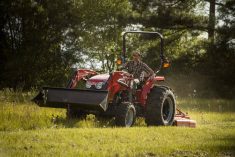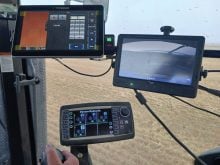REGINA — At 70 feet wide, the new Salford independent, double disc drill mixes what the company thinks is the best of planter and seeder technology.
“Disc drills have some real advantages in western conditions,” said Mark Van Veen of Salford.
“They let you keep your stubble, but if you want that black line for quick warming of the soil in the northern grain belt, you can have that too.”
The new model 525 drill was an evolution of the company’s line of disc tillage and seeding equipment said Van Veen.
Read Also

Growing garlic by the thousands in Manitoba
Grower holds a planting party day every fall as a crowd gathers to help put 28,000 plants, and sometimes more, into theground
“We know this stuff really well and you can’t beat it for precision seed placement. And the power requirement for discs is far lower than shank type machines,” he said while attending Canada’s Farm Progress Show held June 20-22 in Regina.
“You can pull 50 feet on 250 horsepower.”
Colin Montgomery of Perdue, Sask., seeded 600 acres of canola with the 60 foot version of the machine this spring.
“We run a 48 foot hoe drill, and the bigger disc drill took quite a bit less fuel and the 450 horse tractor wasn’t feeling it,” he said.
Montgomery said he became interested in double disc drills after seeing the Horsch Anderson machines in North Dakota.
“I like the job these drills do: low, low disturbance of the soil, precision seed and fertilizer placement,” he said.
The 525 isn’t available only in wider widths. In 10 foot increments, the machine can be as small as 30 feet.
He said the drill also provides good ground penetration.
“We put 320 acres of canola directly into hay land. It cut the (grass) roots. Only where the grass was really heavy did it have issues, and even then it cut through it and somehow we have crop there. It’s that ability to put 500 pounds (of) pressure on the openers.”
Spring pressure puts 500 lb. of packing on each ribbed, four inch wide packer wheel. The packing pressure can be set as low as 90 lb.
“The ribbed packer worked great,” he said. “It put pressure on the seed rows on the sides and less on the seed itself.”
Each pair of 4×6 inch tool bars are placed 11 inches apart. The sets are placed 64 inches from each other, allowing for large amounts of field trash and access to machine settings. Seeding depth is adjustable from the field’s surface to three inches deep.
Van Veen said producers can also use a smaller drill to cover more acres when compared to a hoe drill that can seed only at 3.5 or 4 m.p.h.
Montgomery said he likes that aspect of the double disc drill.
“I’m not that interested in single discs, but the precision of the double is impressive,” he said.
“We seeded at about six (m.p.h.) compared with 3.8 or 4.2,” he said.
Other than some seeding demonstrations at seven m.p.h., Montgomery’s only limiting factor was running out of air seeder cart capacity because of the high rates of product delivered from the seeder cart.
Speed is important for optimum use of the machine, and Salford markets the 525’s six to seven m.p.h. seeding rate as preferable to hoe drills, which travel four to five m.p.h.
The 525 uses soil blowout limiters to keep product and soil inside the seed row. Seedbed firmers ensure good seed to soil contact ahead of the packers.
The 15 inch double discs use an offset blade on the leading unit to cut through trash without tearing out soil.
Coulters can be mounted on the front tool bar to add additional fertilizer to the unit for single pass operation.
This creates an easier cut for the double discs, reduces hair pinning and creates a narrow, black soil zone that allows for the seed row to warm up faster in the spring.
Montgomery said the large tires on the walking beams and frame allowed him to seed through wet conditions.
“Amazing how that heavy machine stayed up, just floating on top,” he said.
Walking tandem axles on the wings carry the tool bars on wide 19/45 x 17 tires, with even larger rubber on the frame and in the middle of the machine.
He said setting the machine’s depth over its 60 foot width took 10 minutes.
“Easy, and you have to like that,” he said. “Plus once it’s running, you don’t have to trust the operator to do anything other than put the machine in the ground and go.”
Hydraulic bolstering cylinders balance the unit from side to side when moving over rolling topography, which keeps the openers in the ground.
Spacings are available in 7.5, 10, 12 and 15 inch widths.
Depending on options, a 60 foot unit lists at about $180,000.
The company has also added a new cart configuration that includes a fourth tank for inoculant or canola. A new 10 chute meter box, up from six, allows peg-type metering, rather than flutes, which can put one to 385 pounds of dry material down per acre.
“Fluted meters can causes surges of seed or inoculant when it comes to applying lower rates. The peg system avoids that,” said Van Veen.
The new plastic and stainless steel tanks and meters are available in 620 or 740 bushel configurations.
The fourth tank is metal and holds 85 bu. It is available in ground drive or hydraulic variable rate and can be given instructions by Raven, Dickey-john or Agtron electronics.
The big cart lists for about $160,000 with dual, 800 series tires.
For more information, contact Van Veen at 519-485-1293 or visit www.salfordmachine.com.

















